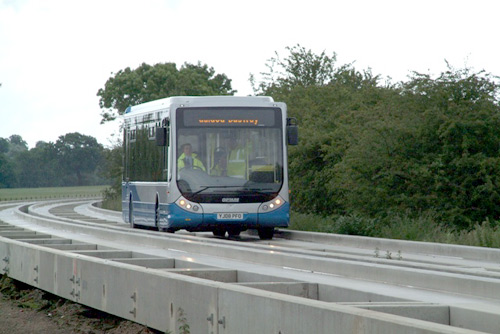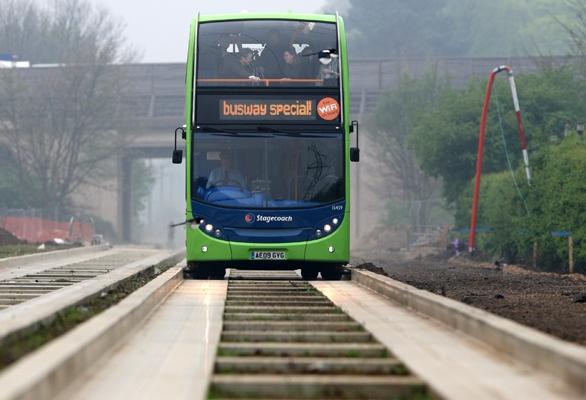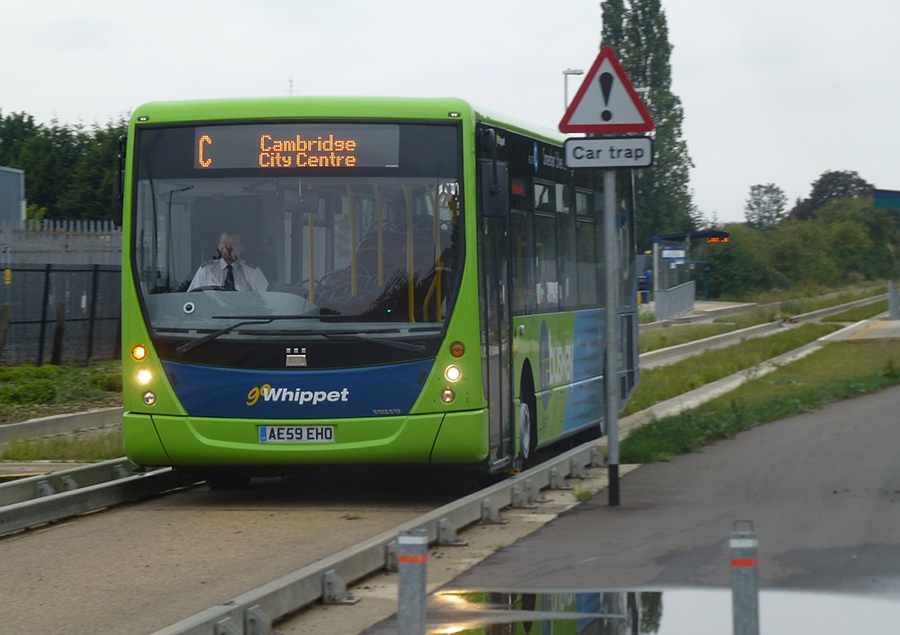Guided bus
Guided bus is the generic term for various transport systems where buses or trolleybuses are performed similar to a web along a predetermined track. Alternate terms are bus trace and trace - trolleybus.
While the early systems are still close-to - bus vehicles used, similar to the latest developments looks more modern trams. These newer systems are called Tramway sur pneumatiques, the German equivalent is tram on rubber wheels.
- 2.1 Bombardier GLT / TVR
- 2.2 Translohr
- 4.1 Civis
- 4.2 AutoTram
O-Bahn
International Transportation Exhibition Hamburg 1979
The principle of guided bus Daimler -Benz ( cars) and Züblin ( track ) on the International Transport Exhibition was first introduced to the general public ( IVA ) in Hamburg in 1979, on the five Mercedes -Benz O at 24 exhibition days were 305 in operation. At that time also called the bus ride or short O-Bahn system were forced out conventional buses on a roadway with side, about 20 centimeters high tracking beams. Are located on the front axle so-called track guide rollers that guide the bus in the lane, articulated buses have also on the rear axles so-called Drängelrollen that secure the distance of the tracking beams in bends. The guided bus can rely on certain sections of this track are conventionally steered by the driver and are threaded through driveways with funnels back on track.
The aim of the O-Bahn was to determine the advantages of railways ( high capacity, small footprint, safer infrastructure, high ride comfort ) and buses to combine ( integration into the road, more flexible development of sparsely populated areas, affordable vehicles manufactured in series ). It provided a modular system that can be both vehicle - and infrastructure- sided gradually expanded. When rolling solo vehicle, articulated or double-articulated cars were provided at the next ordinary Routing traces tunnels and elevated high lines - each with optional overhead line. Track guides it should come primarily in the area of high traffic and served by several lines trunk routes for the application.
Pilot plant Rastatt ( from 1979)
On the Mercedes -Benz plant in Rastatt existed from 1979 an electrified O-Bahn test facility on which the exclusion of the public the various system components were tested.
Later, the system was considerably expanded and presented from 26 to 28 May 1982, the international press. In the final stage, the test facility consisted of two separate sections with approximately three kilometers long, running both buses with mechanical as well as electronic tracking and switches were tested. The roadway consisted of precast concrete parts of the company Züblin with level and elevated sections, as well as a tunnel. A high-speed line was designed for speeds up to 100 km / hr.
A total of four different vehicles arrived at the Rastatt plant for use, they were based on production-based buses and components:
- A 1981 -built O 305 GG ( bi-directional vehicle, pantographs, only in Rastatt in use )
- A 1983 -built O 305 GTD (1986 to the trolleybus Esslingen am Neckar cast)
- Two 1987 -built O 405 GTD (did one of them in 1990 at the trolleybus Kapfenberg )
Long-term experiment in Essen ( since 1980)
A first - Guided bus route was created in 1980 for demonstration purposes in food on a 1.3 -kilometer track in the Fulerumer road and served by the EVAG.
In 1983, a second 1.0 km long route in Wittenberg street, she was traveled to 1986 in mixed mode by tram. There was also the first time the track-guided operation with duo - buses, which possessed in addition to the diesel engine has an electric drive as trolley buses. The track in the Wittenberg road was electrified until 1988.
In 1985, a 3.5 km long stretch in the middle strip of the Ruhrschnellweg motorway ( A 430, 1992 A 40 ) to Essen -Kray loan, which had previously been served by the tram. As of 1991, the track buses were in electrical operation on made-up according to route through the rail tunnel, to the vehicles were also equipped with automatic train protection systems. During an extension of the tunnel in 1991, the vehicles were retrofitted with doors on the left side of the vehicle to operate at two newly opened stations central platforms can. In September 1995, the Spurbusbetrieb was set in the tunnel after numerous faults again, a few days later ended the electrical equipment in the Kray district and thus the duo - bus operation.
For this was already published a tender in 2005, which also called for test vehicle beforehand. In September 2007, then a Citaro II joint car was tested with tower motor for this purpose in the EVAG. The car has been doing testing on all remaining Spurbusstrecken in Essen. The Citaro itself is a production car that was converted at the Neu -Ulm for the Spurbusbetrieb. The car has in the front wheels again to run flat. These make it possible to bring the bus to pull itself out of Spurbusstrecke in case of a flat tire.
Despite the width of 2.55 meters, the test car without problems could drive on the existing lines. Only in the area of the stops the curbs need to be adjusted where they protrude slightly into the Spurbusprofil. This is especially on the way to the Kray case since the curbs were partially displaced by the weather. However, larger adjustments at the track itself are not necessary, so even with the now current vehicles, the system can still be operated. For food to 47 vehicles (16 solo vehicle ( 4151-4166 ) and 31 articulated cars ( 4651-4681 ) ) are supplied.
The Spurbusstrecke in Essen- Fulerum was closed in early 2009. All O 405 N 2 were retired during the year 2009, the solo buses lost their track rollers and are used on other lines. In October 2012, the track was demolished.
Mannheim (1992 to 2005)
In Mannheim - Feudenheim there were, between May 1992 and September 2005, a 800 meter long Spurbusstrecke, which was operating only in one direction. It was created in order to share a separate existing roadbed tram to circumvent a congestion- prone section of road can. Both about 50 centimeters wide lanes were made of wood planks that were laid in the longitudinal direction. The dismantling of the track began in September 2005, since the majority of buses equipped with guide rollers was placed out of service for reasons of age. An upgrade of newer buses was not provided. This also plays a role that newer buses are usually built with a vehicle width of 2.55 meters and thus are five centimeters wider than buses older design, which either costly or custom route modifications would have been necessary. The section was then fitted with an asphalt road and rail track grooves and can be traversed with normal buses.
Worldwide
The world's longest Spurbusstrecke is the route of the Cambridgeshire guided bus between Cambridge and St Ives with 25 kilometers, opened on August 7, 2011. 's Second longest distance of twelve miles was in the Australian city of Adelaide O-Bahn opened in Adelaide on March 2, 1986.
Other installations can be found in the UK, where in Edinburgh, Leeds, Bradford, Crawley, Ipswich and Cambridge Spurbusstrecken exist. A trial section in Birmingham was abandoned again in the meantime. The Spurbusstrecke in Edinburgh was from December 2004 to January 2009 on a part of the route of the future streetcar in operation.
Tramway sur pneumatiques
Bombardier GLT / TVR
In the 1980s, by BN (La Brugeoise et Nivelles ) were developed in Belgium busähnliche double articulated vehicles on eight rubber wheels that are out of a centrally embedded in the asphalt steel grooved rail, but can also be directed conventional. This as GLT ( Guided Light Transport ) designated system could drive electric trolley as in a double catenary or diesel engine. A prototype was presented in Brussels in 1985, from 1988, a test track between Jemelle and Rochefort was operated.
The original high-floor vehicles were developed by Bombardier in the 1990s. As of 1997, the new low-floor vehicles were then referred to as TVR (Transport sur Voie réservée ) (also due to the focus on the French market ).
The first installation of the new system took place in 2000 in the French city of Nancy, where the existing network has been expanded from trolleybuses. The vehicles of the Tramway de Nancy have bipolar current collector and can drive both as a track-guided bus trace as well as on other parts of the route as directed by the driver trolleybuses. The public operation of the STAN began on 11 February 2001, after two accidents in March, the company was, however, shut down for a year and revised the vehicles.
The following installation procedure in Caen, also in France, nearly identical vehicles like Nancy are used. The November 15, 2002, this Tramway de Caen (also called Twisto ) uses single-pole current collector, as they are also used in the tram. As this takes place, the current feedback on the guide rail located at the bottom, only the track-guided operation.
Translohr
Developed by Lohr Industrie technique of Translohr sets like the TVR a centrally recessed rail. The vehicles are bi-directional articulated vehicles, which can only drive on track-guided routes (as opposed to the also free steerable TVR ).
Also referred to as a track trolley bus system was in Paris ( T5) on 29 July, 2013, in Clermont- Ferrand on 14 October 2006 in Tianjin on 6 December 2006, in Padua on 24 March 2007 and in Shanghai opened on 1 July 2009. Also in L' Aquila and Venice / Mestre, Translohr system is installed.
Inductive tracking
In Fürth there from May 1984 to December 1985 an attempt by inductively guided track buses from MAN and Daimler -Benz. The operation was carried out in normal driving conditions on a demonstration plant in the Königswarter road. After the termination of the experiments, however no other routes have been established.
Developed in the Netherlands Phileas used in the roadway embedded magnets for tracking, as well as developed by Toyota 's IMTS.
Inductive tracking is also used in the service tunnel transportation system in the Euro tunnel and many driverless transport systems within larger factories or container terminals.
Optical tracking
Civis
Under the name CIVIS (Latin: citizens ) was developed in France by Renault and Matra, a system intended to combine the advantages of bus and tram. For antitrust reasons, the system later went to the company Irisbus.
With a special ink is applied to the road surface a dashed double-line. A camera follows this flag and an image processing system verifies the information of the camera. The on-board computer then takes over the steering of the vehicle. The driver only needs to accelerate and brake. If there are obstacles in the path trace the driver can regain control. How can a bus Civis dodge obstacles and then thread back to the marking sheet. Advantage is a high flexibility, while driving. There are already 300 buses with this system in use.
The control over the image processing system still holds teething in itself, since the correct recognition and interpretation is sometimes inhibited by environmental influences ( reflections in the wet, snow cover ).
AutoTram
Under the name AutoTram the Fraunhofer Institute for Transportation and Infrastructure Systems (IVI ) in Dresden developed a transport system with optical tracking and the drive by flywheel accumulator.
Roadway
An important design problem in track buses and similar systems in rubber track technology is the design of the superstructure.
Everyone knows the problem, which has become the road surfaces viewed at busy bus stops. There are formed within a few months significant ruts that are there deepened by the braking and appear wavy in the longitudinal profile.
When driving in the tracking this grooving is also reinforced on the open road and causes the grooves need to be replenished periodically. For this reason, the use of asphalt is to be excluded for Spurbusstrecken.
The popular bus stations pavement separates due to the significant reduction in ride comfort from also.
What remains are the most technologically sophisticated coverings made of fiber-reinforced concrete layers with resin bound concrete or steel roadways with textured surface to prevent slippage of the tires. Notlaufvorrichtungen (in case burst tire ) of steel are necessary anyway. In addition, the heating of the roadway is under circumstances in slope sections are necessary to avoid ice formation in the ever- new arising ruts. The driving dynamics of the bus lane is in the higher speed range ( above 25 km / h) high demands on the roadway geometry.
In trackage the ripple formation can sometimes be observed in curves. It arises in particular by inhibiting slightly oscillating movements of the Spurkranzradsätze. The track geometry is adapted to this by a slight movement to the track axis towards falling arrangement of the rail heads and the tapered shaping the Eisenradsätze. Even automobiles have a similar design of the wheel sets to achieve a more stable road holding. The fact though is the fact that even the constant straight-ahead composed of a series of flat pendulum motion of the vehicle about its center of gravity to the left and right. This is with a long straight travel in the tracking for a bus to an essential factor, since the track surfaces must be as well as rail heads inclined slightly inwards to avoid on the trail next to the groove, the ripple formation and thus jolting straight ahead. This in turn requires a precise coordination with the on traffic vehicle.
Areas of application - general findings
Given the demands on the roadway of a track bus is to realize that so much money has to be spent for the reduction of rutting, for the improvement of vehicle geometry and dynamics, safety devices to prevent blowouts and do not last for the various tracking systems that the costs to the respective life -related, with those of a normal track body are comparable. The vehicle cost, however, are significantly lower, but also the life of buses is shorter than that of tram vehicles. Spurbusstrecken are therefore primarily designed as a system supplements in fast-growing small and medium-sized cities with no existing tram service. Do these well-defined, high traffic, but short overland axes for connecting individual scattered settlement parts of the metropolitan area, the guided bus can be the ideal means of transportation here.
The guided bus is also ideal as a placeholder for future axes of higher quality transport and to enhance the attractiveness of existing bus networks, which can be converted due to lack of financial strength only in the long term rail networks. Will not have too high demands on the driving speed and moves them in 30-km/h-Bereich, as well as the infrastructure problems described above with minimal financial expenses are manageable.








